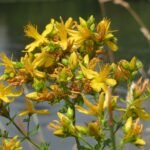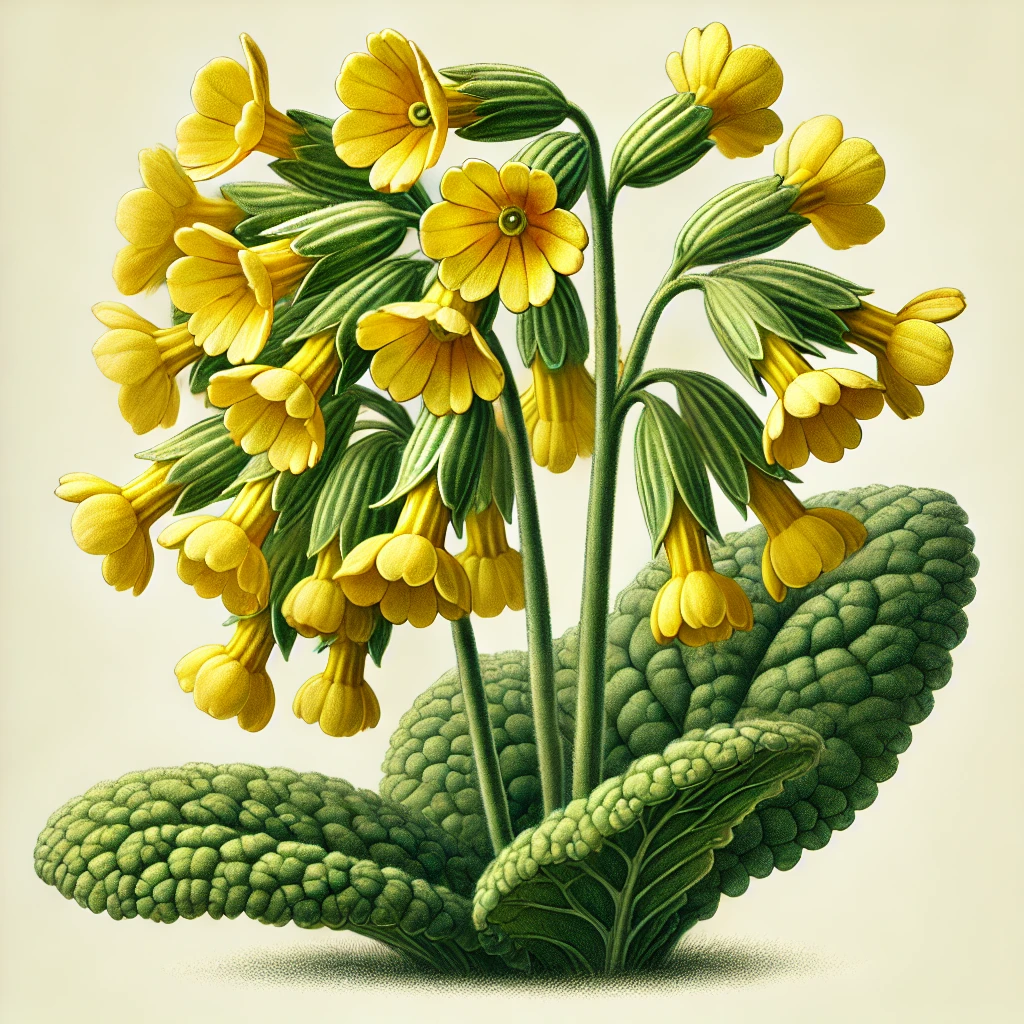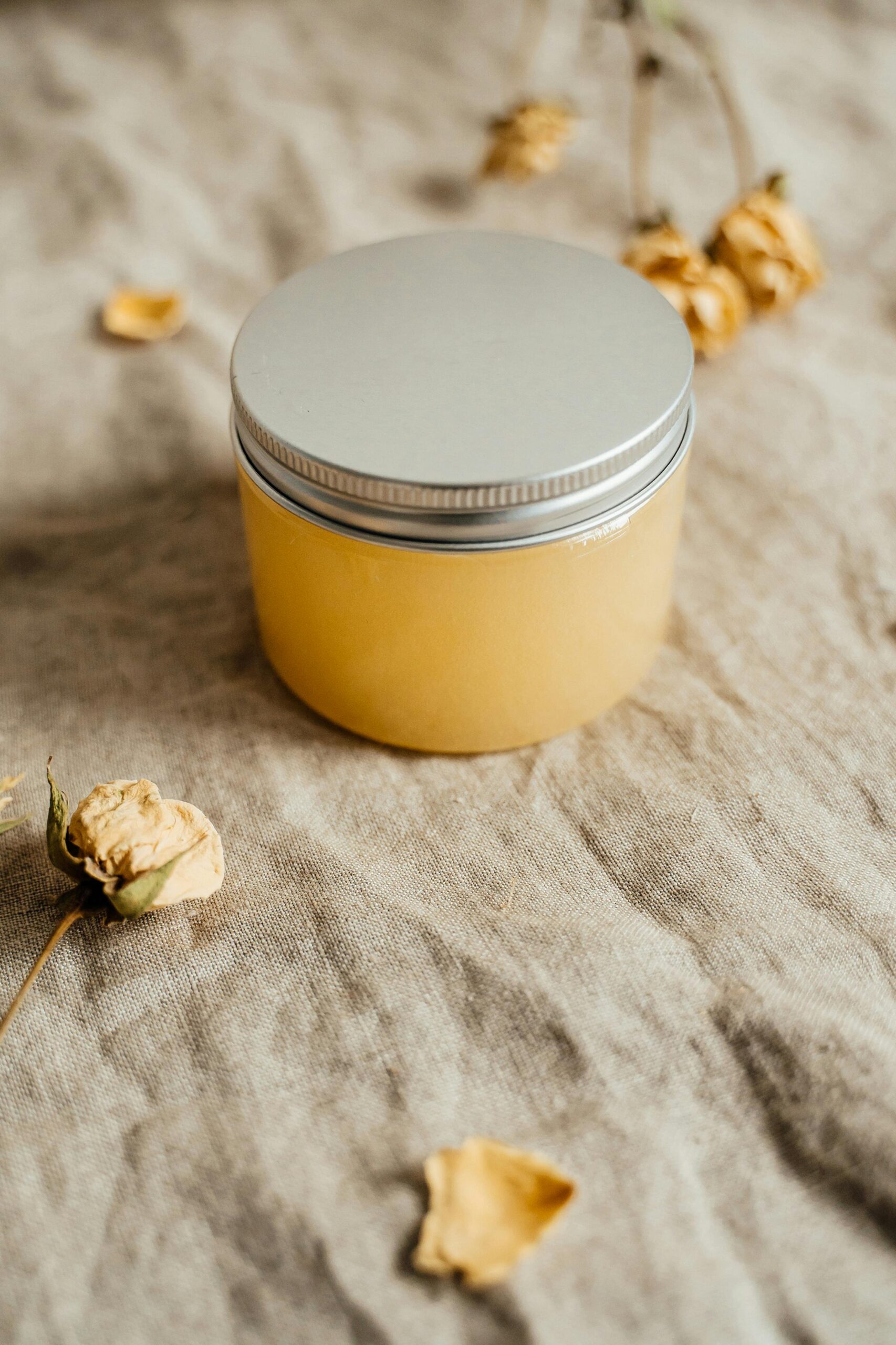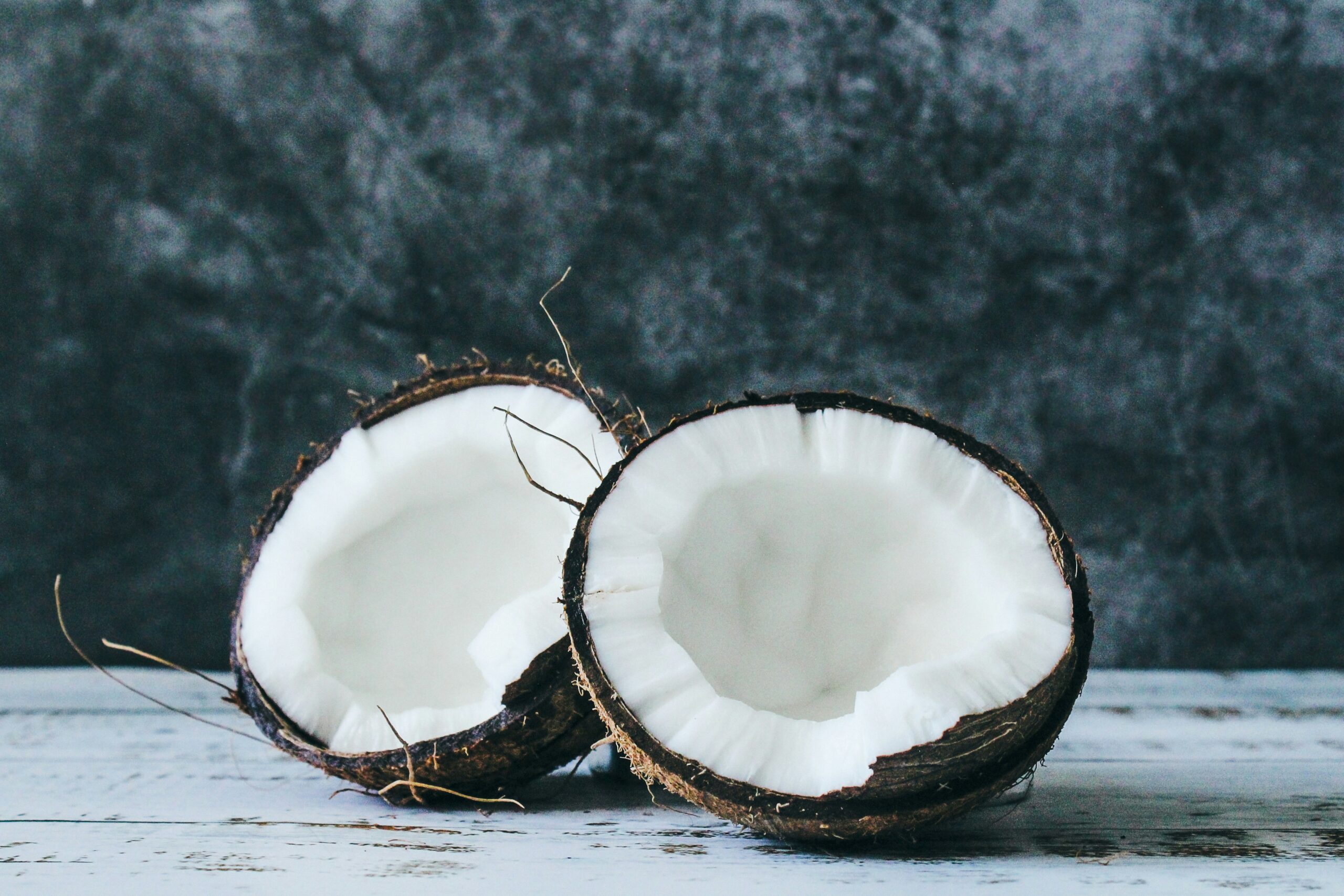Dandelion (Taraxacum officinale): Benefits, Uses and Curiosities
Introduction to the World of Dandelion
Dandelion, known scientifically as Taraxacum officinale, is a perennial herbaceous plant belonging to the Asteraceae family. Native to Eurasia, it has successfully adapted to other corners of the world, becoming a common presence globally. Dandelion is distinguished by its lanceolate, deep green leaves and its bright yellow flowers, which bloom in spring and summer. Mature plants can reach about 30 cm in height, and the flowers—arranged in lamp‑like inflorescences—are attractive to pollinators.
The natural habitat of dandelion is varied, including meadows, roadsides, gardens, and even urban spaces. This versatility contributes to its popularity both as an ornamental garden plant and as a therapeutic tool. In different cultures, dandelion has been recognized for both its medicinal and culinary uses. For example, in traditional medicine, the leaves and roots were employed to treat a variety of conditions, including digestive and liver disorders.

Dandelion is also known by various common names such as “blowball” or simply “dandelion,” each acknowledging its beauty and ease of flourishing under diverse environmental conditions. Throughout history, this plant has been mentioned in ancient texts, and its use has evolved, becoming a symbol of springtime and renewal. In many culinary traditions, dandelion leaves are used in salads or infusions due to their nutritional properties, underscoring the plant’s importance in global food culture.
Nutritional Composition of Dandelion
Dandelion, scientifically Taraxacum officinale, is a remarkable wild plant thanks to its rich nutritional profile. Not only is it packed with antioxidants, but it also provides a variety of essential vitamins and minerals for human health. Dandelion leaves contain significant amounts of vitamins A, C, and K, as well as the B‑vitamin complex. These nutrients play a crucial role in strengthening the immune system, promoting skin and vision health, and maintaining bone integrity.
Beyond vitamins, dandelion is rich in important minerals such as calcium, potassium, magnesium, and iron. Calcium helps fortify bones and teeth, while potassium assists in regulating blood pressure. Iron is essential for hemoglobin formation, improving the body’s oxygen‑transport capacity. Thus, regular consumption of dandelion can benefit overall health by supporting various physiological functions.
Dandelion is also a high‑fiber source, promoting a healthy digestive system. Dietary fiber helps regulate blood sugar levels and contributes to maintaining a healthy body weight by creating a sensation of fullness. This combination of nutrients makes dandelion a valuable ingredient in a healthy diet, with the potential to help prevent chronic conditions like heart disease and type 2 diabetes. In conclusion, dandelion is not just a wild plant but an invaluable nutritional resource that can improve diet quality.
Medicinal Benefits of Dandelion
Dandelion, known scientifically as Taraxacum officinale, is well‑known not only for its distinctive appearance but also for its remarkable medicinal benefits. This plant has been used over time in traditional medicine for its curative properties, which have been supported by numerous scientific studies. One of dandelion’s most important effects is its diuretic activity. Dandelion extracts can stimulate fluid elimination from the body, which is beneficial in combating water retention and kidney problems.
Besides its diuretic effects, dandelion also has significant digestive properties. Consuming dandelion leaves or roots can support digestion and help relieve gastrointestinal discomfort. They contain soluble fibers, which contribute to intestinal health and the regularization of bowel movements. Dandelion can also accelerate fat metabolism and help maintain weight by stimulating bile secretion.
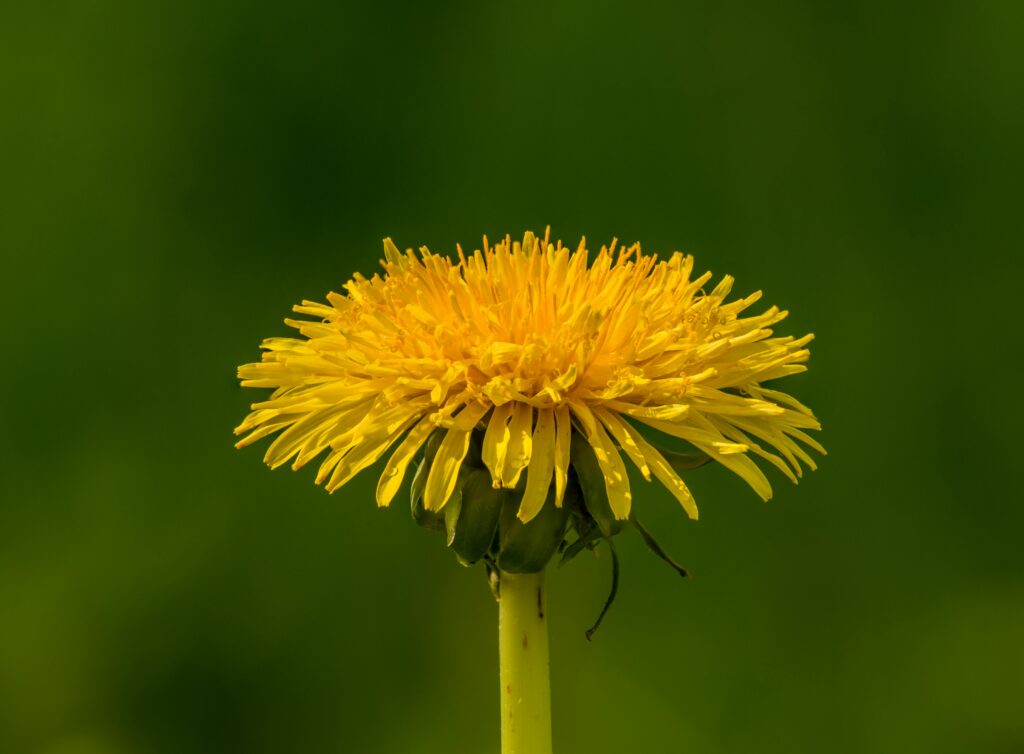
Dandelion’s anti‑inflammatory properties make it a suitable choice for alleviating various conditions, including arthritis and other inflammatory diseases. Recent studies have shown that bioactive compounds in dandelion can reduce inflammation at the cellular level. Therefore, including dandelion in your daily diet can help not only improve general health but also treat chronic conditions. These benefits, along with a long tradition of use, make dandelion a valuable plant in the field of phototherapy.
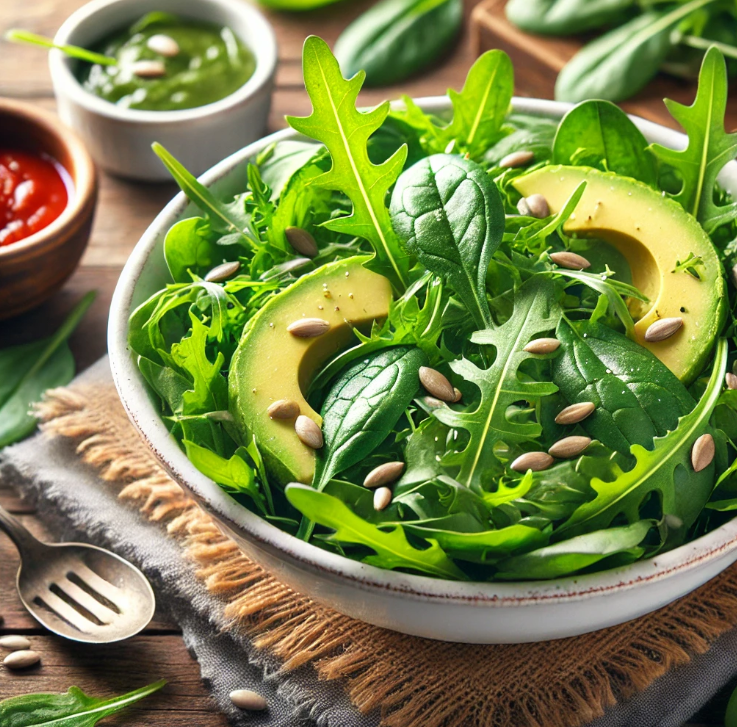
Delicious Dandelion Salad Recipes
Below are some healthy, vitamin‑rich recipes for dandelion salads mixed with other plants:
Dandelion, Spinach and Arugula Salad
Ingredients:
- 1 cup fresh dandelion leaves
- 1 cup fresh spinach
- 1 cup arugula
- 1 avocado, sliced
- 50 g sunflower seeds
- 2 tbsp olive oil
- 1 tbsp balsamic vinegar
- Juice of half a lemon
- Salt and pepper to taste
Preparation:
- Wash the dandelion leaves, spinach, and arugula and place them in a large bowl.
- Add the avocado and sunflower seeds.
- In a small bowl, whisk together the olive oil, balsamic vinegar, and lemon juice.
- Drizzle the dressing over the salad and season with salt and pepper.
Dandelion, Nettle and Radish Salad
Ingredients:
- 1 cup dandelion leaves
- 1 cup young nettle leaves
- 1 bunch radishes, thinly sliced
- 2 tbsp toasted sesame seeds
- 2 tbsp olive oil
- 1 tbsp apple cider vinegar
- Salt and pepper to taste
Preparation:
- Wash the dandelion and nettle leaves (blanch nettles for 1 minute to remove sting).
- Place the leaves and radishes in a large bowl.
- Sprinkle toasted sesame seeds on top.
- Mix olive oil with apple cider vinegar, season, and drizzle over the salad.

Dandelion, Tomato and Cucumber Salad
Ingredients:
- 1 cup dandelion leaves
- 2 large tomatoes, cubed
- 1 cucumber, thinly sliced
- 50 g feta cheese, crumbled
- 2 tbsp olive oil
- 1 tbsp lemon juice
- Salt and pepper to taste
Preparation:
- Wash dandelion leaves and place them in a bowl.
- Add tomatoes, cucumbers, and feta.
- Drizzle with olive oil and lemon juice, season, and toss gently.
Dandelion, Wild Garlic and Walnut Salad
Ingredients:
- 1 cup dandelion leaves
- 1 cup wild garlic leaves
- 50 g roughly chopped walnuts
- 1 tbsp olive oil
- 1 tbsp balsamic vinegar
- Salt and pepper to taste
Preparation:
- Wash dandelion and wild garlic leaves, place in a large bowl.
- Sprinkle walnuts on top.
- Whisk olive oil with balsamic vinegar, season, and drizzle over salad.
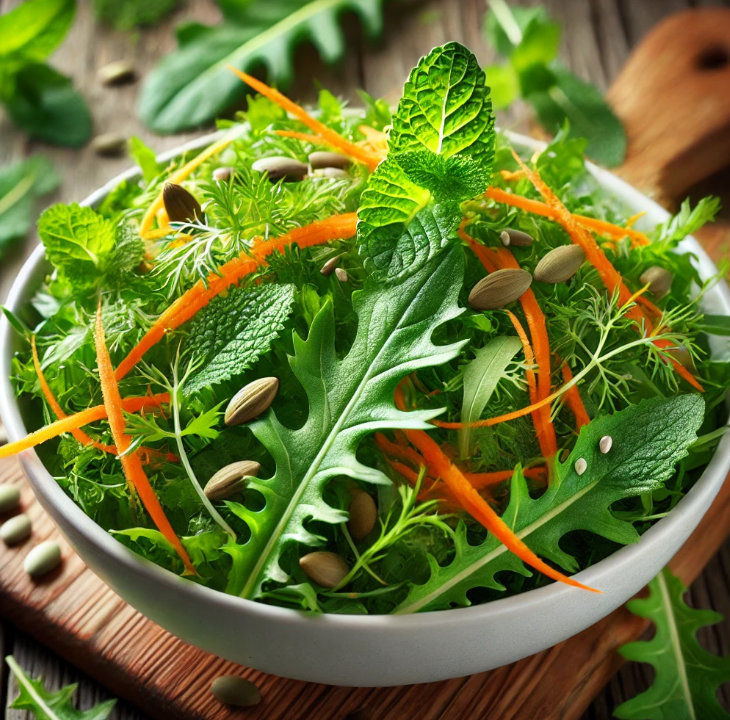
Dandelion, Mint and Coriander Salad
Ingredients:
- 1 cup dandelion leaves
- ½ cup fresh mint leaves
- ½ cup fresh coriander leaves
- 1 carrot, julienned
- 1 tbsp pumpkin seeds
- 2 tbsp olive oil
- 1 tbsp apple cider vinegar
- Salt and pepper to taste
Wash dandelion, mint, and coriander leaves.
Place all ingredients in a bowl, add carrot and pumpkin seeds.
Mix olive oil with vinegar, season, and toss salad.
These salads are fresh, nutritious, and an excellent way to integrate dandelion and other nutrient‑rich plants into your diet.tamine, fiind o modalitate excelentă de a integra păpădia și alte plante nutritive în alimentația ta.
Ways to Use Dandelion
Dandelion (Taraxacum officinale) is a versatile plant with multiple dietary uses due to its rich content of vitamins and minerals. Leaves, flowers, and roots can be easily integrated into various preparations, providing not only nutritional benefits but also a distinctive flavor.
- Leaves can be eaten raw in salads or soups. Their slightly bitter taste can be balanced by combining them with sweeter ingredients like fruits. A simple recipe is a dandelion salad with cherry tomatoes, feta cheese, and nuts, dressed with balsamic vinegar or olive oil.
- Flowers are edible and can be used to prepare teas, tinctures, or even fritters. Dandelion flower tea is valued for its detoxifying and antioxidant properties. To make it, infuse fresh flowers in hot water for ten minutes; it can be enjoyed hot or cold.
- Roots, typically harvested in autumn or spring, serve as a coffee substitute when roasted, providing a similar aroma. They can also be ground and added to culinary dishes like soups or purees to enrich texture and flavor.
Thus, using dandelion in the diet is not only beneficial but also a creative way to add variety to daily meals.
Dandelion in Cosmetics and Personal Care
Dandelion, scientifically Taraxacum officinale, is a versatile plant offering numerous benefits for personal care and cosmetics. Due to its antioxidant, anti‑inflammatory, and moisturizing properties, dandelion extracts are becoming increasingly popular in cosmetic formulations. This plant is rich in vitamins A, C, and E, which are essential for skin health.
One of dandelion’s main benefits for skin is its ability to combat acne. Thanks to its antibacterial properties, dandelion sap can help cleanse pores and reduce inflammation associated with breakouts. Dandelion is also recognized for its detoxifying effects, aiding in toxin elimination, resulting in clearer, more radiant skin.
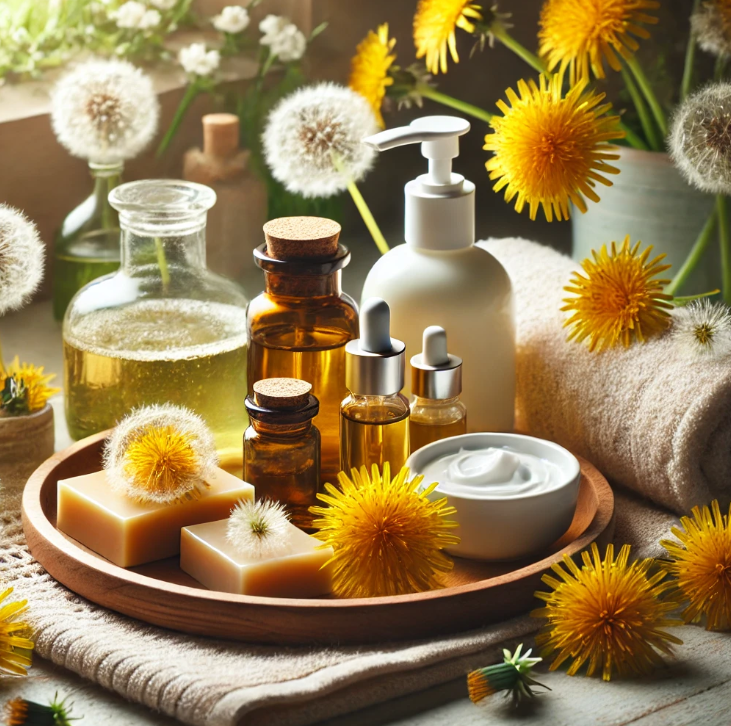
For hair, dandelion can strengthen hair strands and combat dandruff. A decoction of dandelion leaves applied to the scalp can stimulate blood circulation, promoting healthy hair growth. Dandelion oil is prized for its hydrating properties and is an excellent choice for natural shampoos and conditioners.
At home, you can easily create personal care products with dandelion. For example, a facial mask made from finely chopped dandelion leaves mixed with honey and yogurt offers intense hydration and a rejuvenating effect. Additionally, a toner made from diluted dandelion sap can be used to tone and refresh the complexion. By integrating dandelion into your personal care routine, you can achieve noticeable improvements in skin and hair health.
Dandelion-Based Cosmetic and Ointment Recipes
Soothing Dandelion Salve for Dry and Irritated Skin
Ingredients:
- 1 cup fresh dandelion flowers1 cup olive or coconut oil30 g beeswax10 drops lavender essential oil (optional)
- Place dandelion flowers in a jar and cover with oil.Macerate for 2 weeks in a warm place, shaking daily.Strain oil and gently heat with beeswax until melted.Pour into small jars and add lavender oil.Let cool and solidify.
Dandelion has anti‑inflammatory and soothing properties, ideal for dry or irritated skin. Lavender oil adds relaxation and minor inflammation relief.
Dandelion Lip Balm
Ingredients:
- 2 tbsp dandelion‑infused oil (see above)1 tbsp cocoa butter1 tbsp beeswax1 tsp honey (optional)
- Melt beeswax and cocoa butter in a double boiler.Add dandelion oil and honey, stirring well.Pour into lip balm containers and let solidify.
Hydrates and soothes chapped lips. Dandelion aids regeneration of delicate lip skin.
Dandelion Facial Lotion
Ingredients:
- ½ cup dandelion‑infused oil¼ cup rose water2 tbsp beeswax5 drops chamomile essential oil (optional)
- Melt beeswax with dandelion oil in a double boiler.Warm rose water separately.Gradually whisk rose water into melted oil and wax until emulsified.Add chamomile oil and pour into lotion bottles.
Deeply hydrates and soothes skin. Rose water and dandelion have anti‑inflammatory and revitalizing effects.
Dandelion and Brown Sugar Body Scrub
Ingredients:
- ½ cup dried dandelion flowers1 cup brown sugar¼ cup almond or coconut oil1 tsp vanilla extract (optional)
- Crush dried flowers and mix with brown sugar.Add oil and vanilla extract to form a paste.Use in the shower to exfoliate skin.
Dandelion promotes cell regeneration, brown sugar removes dead cells, leaving skin soft. Almond oil deeply moisturizes.
Purifying Dandelion Face Mask
Ingredients:
- 2 tbsp fresh dandelion leaves, chopped1 tsp honey1 tbsp plain yogurt
- Chop leaves finely and mix with honey and yogurt.Apply mask for 15–20 minutes.Rinse with warm water and follow with moisturizer.
Cleanses and detoxifies skin, reduces inflammation and blemishes. Dandelion has anti‑acne and purifying effects.
Conclusion:
Dandelion‑based cosmetics and salves are excellent for hydration, regeneration, and skin soothing. Known for anti‑inflammatory and antioxidant properties, dandelion is ideal for sensitive, dry skin, helping treat minor irritations and inflammation.
Dandelion in Alternative Therapy
Dandelion, scientifically Taraxacum officinale, is a plant with multiple uses in alternative therapy. It is valued in both aromatherapy and phytotherapy for properties that enhance overall well‑being. One common application is as teas or tinctures made from its leaves and flowers, which support liver function and digestion.
In aromatherapy, dandelion essential oil is frequently used in blends to stimulate the immune system and detoxify the body. It can be diffused or used in massage to promote relaxation and reduce stress. Its benefits extend to skin care, recognized for anti‑inflammatory and healing properties; thus, dandelion extracts are included in natural creams and serums for facial care.
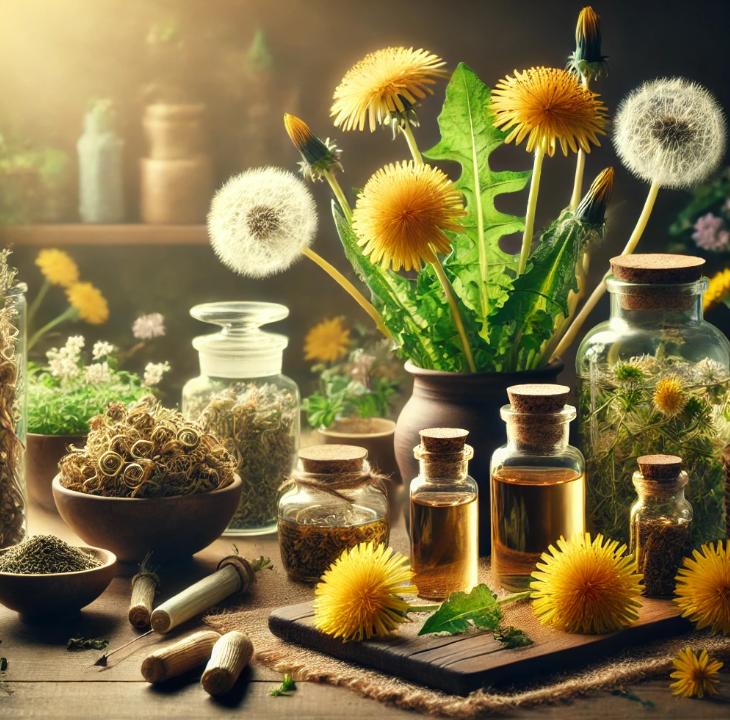
Dandelion is also used in detox therapies for its diuretic effect, aiding in toxin elimination. Integrated into detox diets, it provides vitamins and minerals—such as vitamin C, potassium, and iron—that maintain health. Therefore, dandelion is popular among those seeking natural solutions to improve health and prevent chronic disease.
Dandelion Tincture Recipes
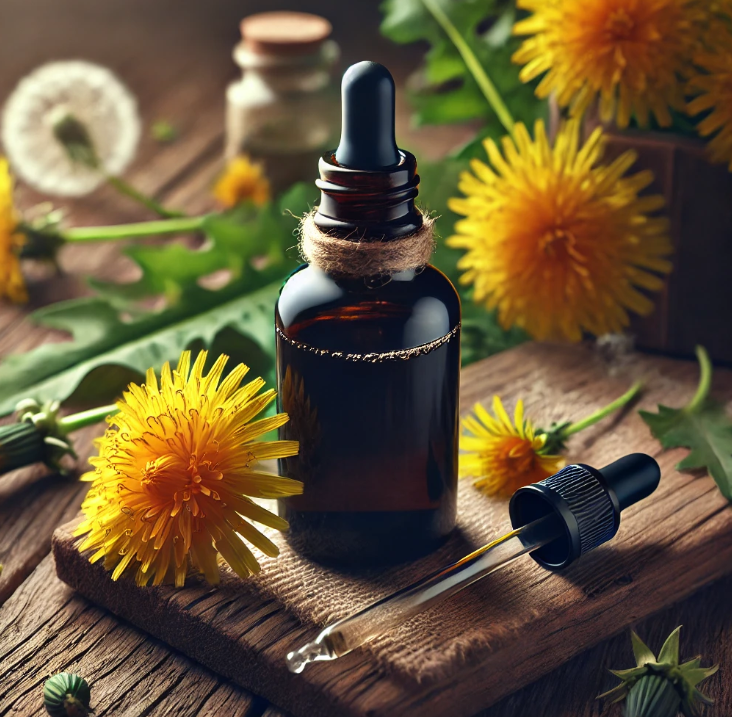
Simple Dandelion Tincture
Ingredients:
- 100 g fresh or dried dandelion roots
- 500 ml 40–50% food‑grade alcohol (vodka or grain alcohol)
Preparation:
- Clean and chop roots finely.
- Place in a glass jar and cover with alcohol.
- Seal and macerate in a cool, dark place for 2–4 weeks, shaking daily.
- Strain through cheesecloth and store in dark glass bottles.
Usage:
10–20 drops in water, 2–3 times daily, for liver detox and digestive support.
Dandelion and Honey Tincture
Ingredients:
- 100 g fresh dandelion leaves
- 300 ml 40% alcohol
- 100 ml organic honey
Preparation:
- Wash and chop leaves, place in a jar with alcohol.
- Macerate for 3 weeks, shaking daily.
- Strain and stir in honey until fully dissolved.
- Store in dark glass bottles.
Usage:
15–20 drops in water or tea, twice daily, for immune support and detox.
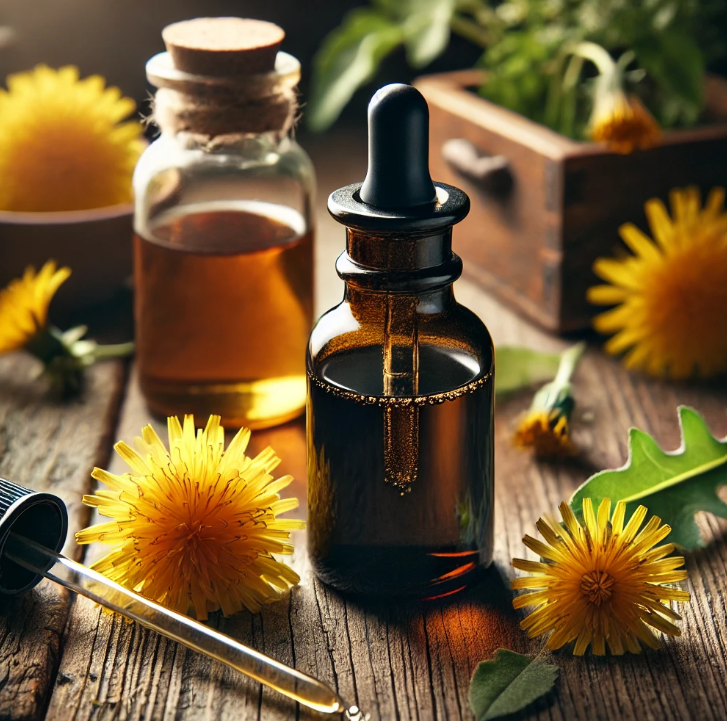
Dandelion and Apple Cider Vinegar Tincture
Ingredients:
- 100 g fresh dandelion roots and leaves
- 500 ml organic apple cider vinegar
- Wash and chop plant material, place in a jar.
- Cover with vinegar, seal, and macerate in a cool, dark place for 2–3 weeks.
- Strain and store in dark glass bottles.
10–15 drops in water, 2–3 times daily, to support digestion and stomach acidity balance.
General Administration:
Dandelion tinctures can be used for liver and kidney detoxification, digestion improvement, bile secretion stimulation, inflammation reduction, immune support, and external treatments for skin conditions or minor wounds. These easy‑to‑prepare at‑home tinctures offer multiple health benefits due to dandelion’s detoxifying and anti‑inflammatory properties.
Curiosities about Dandelion
Dandelion, scientifically Taraxacum officinale, is a plant with a rich history and diverse symbolism worldwide. This yellow flower, often associated with spring, has been valued not only for its nutritional and medicinal benefits but also for the meanings it has acquired across cultures. For example, in many European traditions, dandelion is considered a symbol of hope and rebirth, due to the way its flowers bloom and then disperse seeds, thus restarting the life cycle.
In popular culture, dandelion is often linked to wishes fulfilled. It is said that when someone blows on its fluffy seeds, they can make a wish, believing each airborne seed represents a chance to achieve their dreams. This association with wishes and hope has made the flower popular among children, frequently used in games and traditions.

Historically, dandelion was also regarded as a remarkable plant in traditional medicine. Across cultures, it was used to treat a variety of ailments, from digestive issues to skin conditions. Regardless of region, dandelion evolved as a valuable healing plant, often consumed as infusions or salads. Thus, through its uses, dandelion is not just a simple spring flower but a symbol of nature’s adaptability and human traditions. This fascinating flower continues to inspire and amaze, remaining a subject of study for botanists and nature lovers alike.
Cultivation and Care of Dandelion
Dandelion, scientifically Taraxacum officinale, is a perennial plant that easily adapts to diverse environmental conditions. When cultivating dandelion, it is essential to choose a sunny spot, as the plant prefers direct light. The soil should be well‑drained, fertile, and have a neutral to slightly alkaline pH. To achieve a good dandelion harvest, enrich the soil with compost or other organic fertilizers.
Regarding watering, dandelion requires a moderate regime. Keep the soil moist but not waterlogged. Water consistently, especially during the growing season, to prevent water stress. However, the plant tolerates short drought periods; insufficient watering can affect leaf and root quality.
Fertilization is another key aspect of dandelion care. Use natural fertilizers such as compost or organic amendments twice a year—in spring and autumn. These not only support healthy plant development but also improve soil quality.
Harvest techniques are also important. Leaves and roots can be harvested throughout the warm season, preferably on dry mornings when moisture content is lower. Monitoring for pests like beetles or aphids is crucial. Thinning dandelion plants can improve their resilience and reduce infestation risk.
Conclusions and Recommendations
Dandelion, scientifically Taraxacum officinale, is a remarkable medicinal plant offering numerous health benefits. Thanks to active compounds in its leaves, flowers, and roots, dandelion is valued in traditional and modern medicine alike. Its uses include stimulating digestion, detoxifying the body, and supporting liver health. Dandelion also has antioxidant and anti‑inflammatory properties that contribute to overall well‑being.
Integrating dandelion into the daily diet can provide its nutritional and medicinal benefits. One simple method is adding fresh leaves to salads or smoothies. Flowers can be infused in teas, and roots can be roasted and consumed in various culinary dishes. Nutritional supplements containing dandelion extracts are also available for those seeking its benefits without major dietary changes.

We encourage readers to explore more about dandelion and try various ways to incorporate it into their routines. As a versatile plant, it can make a valuable contribution to general health. However, consult a health professional before starting a dandelion‑based regimen, especially for individuals with preexisting conditions or on medication. In conclusion, through its multiple uses, dandelion is a precious natural resource worthy of our attention.
Frequently Asked Questions
What is dandelion and why is it considered a valuable plant?
Dandelion (Taraxacum officinale) is a perennial herbaceous plant of the Asteraceae family, known for its bright yellow flowers and lanceolate green leaves. It is valuable due to its versatility in medicine, diet and cosmetics. Its leaves, flowers and roots contain vitamins, minerals and antioxidants beneficial for human health, being used for body detoxification, improved digestion and inflammation treatment.
What are the main nutritional benefits of dandelion?
Dandelion is rich in vitamins A, C, K and B‑complex, which support immunity, bone health and skin. It is also an excellent source of minerals such as calcium, iron, potassium and magnesium. These nutrients help maintain cardiovascular health, improve digestion and prevent anemia. In addition, its high fiber content supports intestinal health.
How does dandelion help detoxify the body?
Dandelion stimulates liver and kidney function thanks to its diuretic properties. It helps eliminate toxins and excess fluids from the body. Dandelion root, in particular, is used to increase bile production, facilitating fat digestion and liver cleansing.
What role does dandelion play in improving digestion?
Dandelion contains soluble fibers and bitter compounds that stimulate the secretion of digestive juices and bile, facilitating food digestion and reducing bloating. It also helps regulate bowel transit and prevent constipation, benefiting the intestinal microbiome.
How can dandelion be consumed in the diet?
Dandelion can be consumed in various forms: fresh leaves added to salads or smoothies, flowers used in teas and syrups, and roots roasted and used as a coffee substitute. A popular recipe is dandelion salad with spinach, arugula, avocado and seeds, offering a significant nutrient boost.
What are the main medicinal uses of dandelion?
In traditional medicine, dandelion is used to treat digestive problems, detoxify the liver and combat inflammation. Its diuretic properties are useful for people with water retention or kidney conditions. Dandelion is also used to support immunity and reduce the risk of chronic diseases due to its antioxidant content.
What benefits does dandelion bring to the cosmetic field?
Dandelion is used in cosmetic products for its antioxidant, anti‑inflammatory and moisturizing properties. Extracts from leaves or flowers are included in creams and masks to soothe irritations and hydrate the skin. A dandelion decoction can be used to rinse hair, reducing dandruff and stimulating growth.
How can dandelion be used in alternative therapy?
In alternative therapy, dandelion is employed as teas, tinctures and essential oils for detoxification, stress reduction and improved digestive function. Dandelion root tinctures are prized for liver support, while the essential oil is used in massage for relaxation and to stimulate blood circulation.
What contraindications and side effects can dandelion have?
Dandelion is generally safe but can cause allergic reactions in people sensitive to plants of the Asteraceae family. Excessive consumption may lead to gastric discomfort or diarrhea. Additionally, dandelion can interact with diuretic or anticoagulant medications. It is recommended to consult a physician before use, especially for those with preexisting conditions.
What interesting curiosities exist about dandelion?
Dandelion is considered a symbol of rebirth and hope in many cultures. In popular tradition, blowing its fluffy seeds into the air is associated with wish fulfillment. Although often seen as a weed, dandelion is one of the most resilient plants, capable of growing in almost any soil. It has also been used as a natural source of latex for rubber production.











